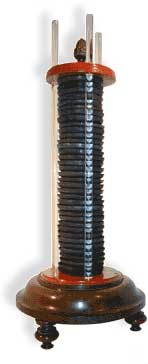| Contact |
| Back | Next | Home |
Invention
of the Battery
The Volta Pile
|
|
Count Alessandro Volta,(1745-1827), Italian physicist, is known for his pioneering work in electricity. In 1774 he became professor of physics at the Royal School in Como, and in the following year he devised the electrophorus, an instrument that produced charges of static electricity. In 1779 he became professor of physics at the University of Pavia, and held that position for 25 years.
In 1800 Volta developed the voltaic pile, a forerunner of the electric battery. The first pile consisted of a number of discs of zinc and silver separated by pieces of wet paper and arranged in a vertical column. This was the first device to produce a steady stream of electricity and could operate for decades. In honor of his work in the field of electricity, Napoleon made him a count in 1801. The electrical unit known as the volt was named in his honor.
Early Cells and Batteries:
  
Volta Piles |
This early acid jar battery was used widely in electrical experiments during the last quarter of the 19th century. For more information and a photo of Thomas Edison using the cell, click here. |
|
| Contact |
| Back | Next | Home |